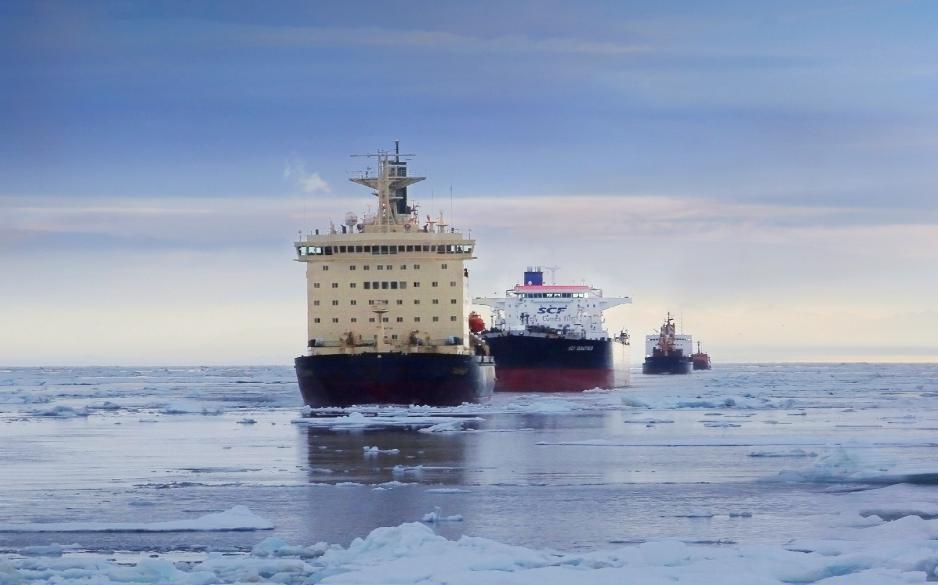Rosatom To Invest $7bn in Arctic Shipping to Compete with Suez Canal

Shipping convoy along Russia’s Northern Sea Route (Source: Courtesy of Rosatom)
Russia’s Rosatom Group plans to spend $7 billion to become one of the world’s largest container shipping operators. The company aims to offer container liner service along the Arctic’s Northern Sea Route (NSR), a shortcut between Asia and Europe, competing with the Suez Canal.
Shipping traffic along Russia’s Arctic coastline continues to be at an all-time high reaching nearly 30 million tons in 2019. The vast majority of this traffic comes from the transport of oil and gas and general cargo. Container shipping, however, has been very limited, with Danish shipping giant Maersk as the first company to send a container ship along the NSR last year. Now, the state-owned Rosatom Group is in talks with VTB Bank, one of the country’s largest banks, to secure $7 billion in funds to acquire up to 55 ice-class container ships and upgrade port facilities along the NSR, news agency Interfax reports.
While most shipping experts remain skeptical that container shipping in the Arctic is economically feasible, Russia appears set on stepping into direct competition with the Suez Canal. Just last month, the Ministry for the Development of the Far East put forth a proposal to create a state-run container shipping company offering service between Murmansk in the West and Kamchatka in the East. In fact, many aspects of Arctic shipping require government subsidies.
“Very little of Russia’s marine activity and shipping in the Arctic can exist without the government subsidizing many elements of the operation,” explained Lawson Brigham, Professor of Geography & Arctic Policy at the University of Alaska Fairbanks.
Pushing ahead despite environmental concerns
This latest Russian initiative stands in direct conflict with efforts by environmental advocates to limit the amount of shipping activity in the region, in part due to the risk emanating from the use of heavy fuel oil and black carbon emissions. In recent months several of the world’s largest container shipping companies, including CMA CGM and Hapag Lloyd, announced that they would not operate in the Arctic, citing environmental concerns.
In contrast, Russia and its state-owned companies are pushing ahead with the development of Arctic shipping routes as an avenue to export the country’s vast oil and gas resources. And, if Rosatom succeeds, transport millions of cargo containers along the route.
The company plans to begin container service along the route next year. However, it remains unclear what vessels it will be using for the service as it does not operate any container ships and ice-class container ships are commonly purpose-built for shipping operators, e.g. for service in the Baltics.
Rosatom in the Arctic driver’s seat
Rosatom Group designs, builds and operates 35 nuclear plants in Russia and sells nuclear technology abroad. Its subsidiary, Rosatomflot operates the country’s four nuclear icebreakers, one nuclear-powered cargo vessel and a number of other icebreakers and service vessels. In 2018 Rosatom icebreakers escorted 331 vessels transporting 12.7 million tons of cargo along the NSR.
Last year Rosatom was placed in charge of shipping, security, and infrastructure on the Northern Sea Route – demoting the Ministry of Transport – in a further sign that Rosatom’s role along the route is likely to expand in the years to come.
Lofty forecasts may conflict with reality
The development of oil and gas resources in Russia’s Arctic has often outpaced expectations, including Novatek’s record-breaking Yamal LNG natural gas plant. Container shipping, however, relies on a highly sophisticated logistics network, including a reliable year-round schedule, which may be impossible to replicate along the ice-covered waters of the Northern Sea Route.
“Serious questions have been raised about the commercial viability of establishing regular container routes, for several reasons. Due to shallow straits, the bigger – and most economic - container vessels can’t pass, the route is only usable part of the year, and even in the summer season ice can delay journeys, making it impossible to guarantee just-in-time deliveries,” confirms Arild Moe Senior Research Fellow at the Fridtjof Nansen Institute.
Less ice, more opportunities?
A number of studies, including a widely-cited report by the Copenhagen Business School, concluded that container shipping through the Arctic is currently not economical. However, as Arctic sea ice continues to decrease some of those calculations may change, as the study concludes that “the feasibility of liner shipping [in the Arctic] is highly dependent on the annual number of navigation days along the NSR.”
Maybe it is the continued decrease in sea ice coupled with new nuclear icebreakers becoming available to escort ships through the ice, that inform Rosatom’s very optimistic predictions. By 2023 the company forecasts revenues of $700 million, reaching $5.6 billion in 2026. In order to finance such a massive expansion of its operation, the operator is looking to secure a $3.5 billion loan from VTB bank. The other 50 percent of the investment will come from Rosatom’s funds and from reinvestments of the projected revenue of the container service.
By the end of the next decade the company aims to transport 72 million tons of cargo per year, of which 43 million tons would be containerized – matching world leader Maersk. In comparison the Suez Canal sees approximately 980 million tons of cargo, of which 570 million tons are from container cargo.

